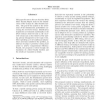621 search results - page 35 / 125 » DNA Computing |
ISMB
1994
13 years 11 months ago
1994
Adaptive resonance theory (ART)describes a class of artificial neural networkarchitectures that act as classification tools whichself-organize, workin realtime, and require no ret...
ISMB
1993
13 years 11 months ago
1993
Thoughit has been possible in the past to learn to predict DNAhydration patterns from crystallographic data, there is ambiguity in the choice of training data (both in terms of th...
HEURISTICS
2002
13 years 10 months ago
2002
In the paper, a new hybrid genetic algorithm solving the DNA sequencing problem with negative and positive errors is presented. The algorithm has as its input a set of oligonucleo...
JMLR
2010
13 years 5 months ago
2010
This paper focuses on the use of nuclear DNA Short Tandem Repeat traits for the identification of the victims of a Mass Fatality Incident. The goal of the analysis is the assessme...
BMCBI
2007
13 years 10 months ago
2007
Background: Computational methods to predict transcription factor binding sites (TFBS) based on exhaustive algorithms are guaranteed to find the best patterns but are often limite...

